CDC/DOJ Survey - Men more often victims of intimate partner violence (USA)
SUMMARY: According to a 2010 national survey by the Centers for Disease Control and U.S. Department of Justice, in the last 12 months more men than women were victims of intimate partner physical violence and over 40% of severe physical violence was directed at men. Men were also more often the victim of psychological aggression and control over sexual or reproductive health. Despite this, few services are available to male victims of intimate partner violence. This paper explores the extent of intimate partner violence against male victims. It looks at the domestic violence system response to male victims. It re-examines data from the U.S. Centers for Disease Control National Intimate Partner and Sexual Violence Survey, research on the impact of IPV on male victims and the system´s response to it. More research is needed on IPV against men, its impact on men and the domestic violence service response to male victims. Public education is needed on the extent of IPV against males, and services need to be provided for these victims. Increased domestic violence education directed at women and services to men should lead to a reduction of DV against women as well as men, since woman aggressors frequently are themselves victimized subsequently.
Public education efforts about intimiate partner violence should not be gender-neutral, but should be specifically addressed to woman and girls as well as boys and men.
State programs need to ensure that domestic violence services are provided to men across the state.
Physical violence
More men than women were victims of intimate partner physical violence within the past year, according to a national study funded by the Centers for Disease Control and U.S. Department of Justice. According to the National
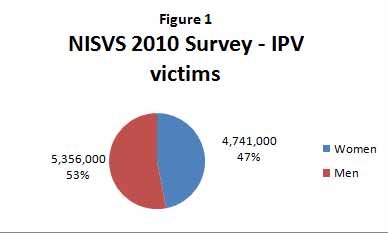
Intimate Partner and Sexual Violence Survey (hereinafter NISVS) released in December, 2011, within the last 12 months an estimated 5,365,000 men and 4,741,000 women were victims of intimate partner physical violence. (Black, M.C. et al., 2011, Tables 4.1 and 4.2) 1 This finding contrasts to the earlier National Violence Against Women Survey (Tjaden, P. G., & Thoennes, N., 2000)(hereinafter NVAWS), which estimated that 1.2 million women and 835,000 men were victims of intimate partner physical violence in the preceding 12 months. (One-year prevalence "are considered to be more accurate [than lifetime rates] because they do not depend on recall of events long past" (Straus, 2005, p. 60))
If one adds in rape (606,000 victims) the total is 5,427,000 women-but there is an issue of double-counting of an incident as both rape and intimate partner physical violence. 2 Of the lifetime rape victims, 82.8% were also victims of physical violence. This suggests that a sizeable portion of the 606,000 rape victims are included in the 5,427,000 physical violence victims. But even if one ignores the double-counting of rape and physical violence, the number of female victims of rape and/or physical violence is 5,427,000 for women, contrasted with 5,365,000 male victims of physical violence, so it is safe to say that about half of the victims of physical violence are men.
There is a significant difference between the NVAWS and NISVS surveys, in the number of victims of physical violence (4,741,000 vs. 1,300,000 women and 5,365,000 vs. 835,000 men), for which I have no explanation.
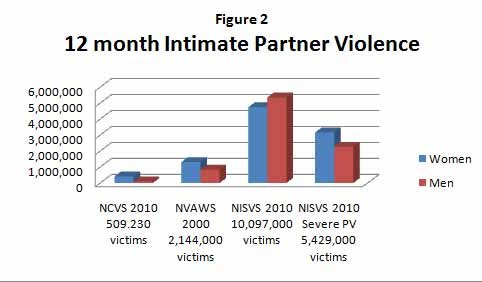
In the 2001 NVAWS survey, some 38% of the victims of intimate physical violence were men, but in the 2011 NISVS survey 53% were men. This is consistent with earlier studies showing that between 1975 and 1992 (Straus and Gelles, 1988, Straus, 1995), between 1998 and 2005 (Catalano , 2005) and between 2009 and 2010 (Truman, 2011, Table 6) violence against women dropped but violence against males stayed steady. (As a point of reference, Statistics Canada (2006, 2011) reports that 45.5% of the victims of present or former spousal violence were men. The 2010 National Crime Victimization Survey (Truman, 2011, Table 5) shows only 407,700 female and 101,530 male victims of intimate partner violence: for women that's less than a tenth of the victims reported in NISVS.)
This drop in intimate partner violence against females and steady rate of violence against males raises an interesting policy question. Given that there are many thousands of support programs, Web sites and public-interest media items for female victims of domestic violence, and no programs and only a handful of Web sites for male victims, perhaps males, but not females, have got the message that domestic violence is wrong. There are many programs for men to stand up against domestic violence by men, and no programs urging women to stand up against domestic violence by women.
This ratio of men to woman victims of intimate partner physical violence is not reported in the Executive Summary or other fact sheets of the NISVS survey. Instead, the NISVS focuses on severe physical violence-but omits a major contributor to severe physical violence against men reported in the earlier NVAWS survey. Some 21.6% of the male victims in that 2001 survey were threatened with a knife, contrasted to 12.7% of the women (Hoff, 2001, Table 1). The NISVS omission of threats by knife or gun is not only curious, but it flies in the face of the Centers for Disease Control's own recommendations on data for intimate partner violence (Salzman, T. et al, 1999)
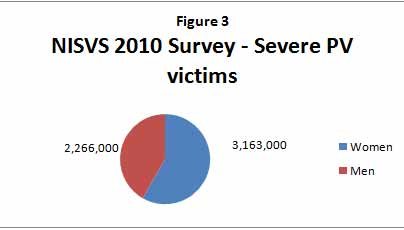
The section of that document that covers the victim's experience of intimate partner violence includes sections on sexual violence, physical violence, threats of physical or sexual violence and "psychological / emotional abuse." (Salzman, T., 1999, §3.3) 3 But NISVS survey respondents were not asked about being threatened with a knife or gun.
Notwithstanding that omission, the NISVS 2011 survey reports that in the last 12 months, 41.7% of the victims of severe physical violence were men. (Tables 4.7 and 4.8) 4 Of the 4,741,000 female victims of violence, two-thirds (3,163,000 or 66.7%) were subjected to severe physical violence. (Table 4.7) For men, over 4 out of 10 (2,266,000 or 42.3%) were subjected to severe physical violence. The number of men is smaller, but that is still 2.26 million men. Well over $1 billion is spent to help female victims, but there are virtually no services available in the country for over 2 million men who are victims of severe physical violence by an intimate partner.
Psychological aggression, control of reproductive or sexual health
What is more violent, brandishing a knife at your spouse in the heat of an argument, refusing to wear a condom, or calling your spouse fat or stupid? NISVS did not ask about knife-wielding, but did ask about condoms and name-calling. Men were more often the victims of both psychological aggression ("expressive aggression" and "coercive control") and control of reproductive or sexual health.
Name-calling is one of the forms of "expressive aggression," which includes acting angry in a way that seemed dangerous, name-calling and insulting remarks. 5 The other category of "psychological aggression" is "coercive control," such as restricting access to friends or relatives and having to account for all your time. 6 In the last 12 months, 20,548,000 men (18.1%) and 16,578,000 (13.9%) women were subjected to psychological aggression.
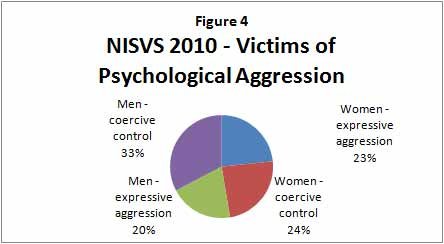
For women, this was split fairly evenly between expressive aggression and coercive control, while for men, 15.2% were subjected to coercive control and 9.3% to expressive aggression. The main forms of expressive aggression against women were insults (64.3%) and name-calling (58.0%). For men the top items were being called names (51.6%) and being told they were losers (42.4%)
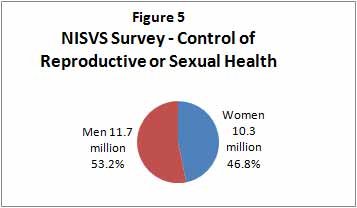
NISVS did not present detailed data on control of reproductive or sexual health. It summarized that "Approximately 10.4% (or an estimated 11.7 million) of men in the United States reported ever having an intimate partner who tried to get pregnant when they did not want to or tried to stop them from using birth control." (p. 48). "Approximately 8.6% (or an estimated 10.3 million) of women in the United States reported ever having an intimate partner who tried to get them pregnant when they did not want to." P. 48)
What services are available for men?
Studies show that men are less likely than women to seek help, and those that do have to overcome internal and external hurdles. (Galdas et al., 2005)(Cook 2009)
There has been little research on responses to male victims of intimate partner violence, in part because agencies refuse to fund such research. For example, the U.S. Department of Justice solicitation of proposals for Justice Responses to Intimate Partner Violence and Stalking (p. 8) stated "What will not be funded: 4. Proposals for research on intimate partner violence against, or stalking of, males of any age or females under the age of 12." In the few studies done, many men report that hotline workers say they only help women, imply or state the men must be the instigators, ridicule them or refer them to batterers' programs. Police often will fail to respond, ridicule the man or arrest him. (Cook 2009)(Douglas and Hines, 2011)
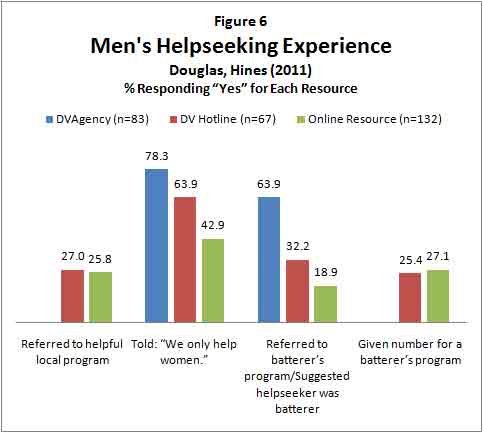
In 2008 Douglas and Hines conducted the first-ever large-scale national survey of men who sought help for heterosexual physical intimate partner violence. (Douglas and Hines, 2011) Some 302 men were surveyed. This study found that between half and two-thirds of the men who contacted the police, a DV agency, or a DV hotline reported that these resources were "not at all helpful." The study elaborates:
A large proportion of those who sought help from DV agencies (49.9%), DV hotlines (63.9%), or online resources (42.9%) were told, "We only help women." Of the 132 men who sought help from a DV agency, 44.1% (n=86) said that this resource was not at all helpful; further, 95.3% of those men (n=81) said that they were given the impression that the agency was biased against men. Some of the men were accused of being the batterer in the relationship: This happened to men seeking help from DV agencies (40.2%), DV hotlines (32.2%) and online resources (18.9%). Over 25% of those using an online resource reported that they were given a phone number for help which turned out to be the number for a batterer's program. The results from the open-ended questions showed that 16.4% of the men who contacted a hotline reported that the staff made fun them, as did 15.2% of the men who contacted local DV agencies. (p. 7)
Police arrested the man as often as the violent partner (33.3% vs. 26.5%) 7 . (p. 8) The partner was deemed the "primary aggressor" in 54.9% of the cases. In 41.5% of the cases where men called the police, the police asked if he wanted his partner arrested; in 21% the police refused to arrest the partner, and in 38.7% the police said there was nothing they could do and left.
Some 68% of the men turning to mental health professionals said the professional took his concern seriously, but only 30.1% offered information on how to get help from a DV program. Although 106 men suffered severe physical injury, only 54 sought help from a medical provider. Some 90.1% were asked how they got their injuries, and 60.4% answered truthfully. Only 14% got information on getting help from a program for intimate partner violence.
The best source for help was friends, neighbors, relatives, lawyers, ministers and the like. 84.9% turned to one or more of these sources, and 90% found them helpful. Two-thirds of the men sought online help and support, with half the men surveyed using Web sites and a quarter using an online support group. Some 69.1% found online support helpful; 44.9% used a resource for male victims and 42.6% for anyone experiencing partner aggression.
The study concludes that informal help, mental health and medical services were the most helpful. The services least helpful were
those that are the core of the DV service system: DV agencies, DV hotlines, and the police. On the one hand, about 25% of men who sought help from DV hotlines were connected with resources that were helpful. On the other hand, nearly 67% of men reported that these DV agencies and hotline were not at all helpful. Many reported being turned away. The qualitative accounts in our research tell a story of male helpseekers who are often doubted, ridiculed, and given false information. (p. 10)
This failure of service impacts men's physical and mental health.
Specifically, for each additional negative experience with helpseeking, men's odds of meeting the cut-off for PTSD increased 1.37 times. For each additional positive experience, these helpseekers were about 40% less likely to have abused alcohol in the previous year. These findings hold even after controlling for other traumatic experiences, such as childhood victimization and being injured by a partner. (p. 10)
The NISVS survey makes a half-hearted effort to remedy this situation. Buried in its recommendations is the sentence "It is also important that services are specifically designed to meet the needs of a wide range of different populations such as teens, older adults, men, gay, lesbian, bisexual, and transgendered people." We can do better than this.
What should we do?
We need to recognize intimate partner violence by women, understand it, and recognize it as a serious social problem.
Public service announcements need to be de-gendered. Right now, they focus almost exclusively on intimate partner violence against women. There needs to be more public education about violence to men. There are many Web sites on intimate partner violence against women. These are all woman-centered, or use gender-neutral language. They tend to minimize violence against men. There is only a handful of sites addressing domestic violence against men. None of these (except for the Clark County IN prosecutor's site) receive any government, foundation or corporate support.
Feminist theory states that intimate partner violence is an accepted form of "power and control" by men in a patriarchal society. But according to Straus (2011) the predominant immediate motives for violence, by women as well men, are frustration and anger at some misbehavior by the partner. "They are efforts to coerce the partner into stopping some socially undesirable behavior or to practice some socially desirable behavior. … Studies have found that women engage in coercive control as much as men."
Further, intimate partner violence is more likely to be mutual or female-initiated than male-initiated. In an analysis of 36 general-population studies on IPV and dating violence, Straus (2011) found that women were half again as likely to perpetrate serious physical violence. The 14 studies which also examined whether the violence resulted in physical injury showed that men inflicted injuries more often than women, but the difference was not that great. The rate for women injuring a partner was 88% of the male rate. Studies with a high percentage of men inflicting injury are, without exception, also studies with a high percentage of women injuring a partner.
Straus found that the typical pattern is that when there are severe assaults, in almost half couples, both severely assault. The two studies with extremely high rates of mutual assault (68% and 78%) are studies of very young couples and those results are consistent with a large number of studies that have found extremely high rates for very young couples. Studies which asked specifically about self-defense found that only a small percentage of female assaults were in self-defense, such 5, 10, or 15. For one study that found high rates of self-defense, the percentage was slightly greater for men (56%) than for women (42%) (Harned, 2001).
There is other evidence which casts doubt on the idea that intimate partner violence by women is primarily in self-defense. Eight studies providing data on who hit first have found that women initiate from 30 to 73% (median=45%) of violent incidents. One found high rates of violence by women, even when male violence was statistically controlled.
Is there "gender symmetry" in intimate partner violence? As Straus (2011) points out, studies often confound symmetry in perpetration with symmetry in effect. Women do experience more physical injury and psychological impact, but men experience these as well (Douglas & Hines, 2010). As IPV expert Strauss puts it, saying that violence by women is not a serious social problem "is like arguing that cancer is not an important medical problem because many more die of heart disease." (2011, p. 284)
In the last 12 months 5.4 million men were victims of intimate partner violence, 2.3 million victims of serious physical violence, yet there are virtually no programs to serve them.
Intimate partner violence by women increases the chances that they will themselves be victims of intimate partner violence.
Intimate partner violence is morally wrong and criminal, but there are few programs for women batterers to show them better ways to resolve conflicts in a relationship.
Public education efforts are need to focus on girls and women. As Straus (2011, p. 285) states,
It is not sufficient for prevention programs to be gender neutral. They need to be explicitly directed to girls and women as well as boys and men. In addition, more than just awareness of female perpetration is needed. The target audience of women and girls also needs to be informed that PV by a woman is morally wrong, a criminal act, and that it is a danger to women because it increases the probability of her partner being violent (Straus, 2005).
States need to offer domestic violence services to men. Many say they do, but none have data on the number of men served. Some of these programs for men are male batterer programs. The Valley Oasis Center in California and a program in Longview, WA are two of only a handful of DV programs offering equal services to men. In King County (Seattle) when I asked about services for battered men I was referred to a male better program. The Snohomish County program north of Seattle says they serve males, but men who have tried to get help inform me they were sent away. Courts in California and West Virginia have found that DV programs discriminate on the basis of sex, in violation of equal protection provisions of their constitutions. (Woods v. Horton, 2008).
In short, we need to recognize that intimate partner violence is a people problem, not a women's problem.
Acknowledgements
I would like to thank Dr. Denise Hines (Clark University, Clark Anti-Violence Education, CAVE) and Dr. Murray Straus (University of New Hampshire, Family Research Laboratory) for comments and suggestions which aided in revising the paper.
References
Black, M.C., Basile, K.C., Breiding, M.J., Smith, S.G., Walters, M.L., Merrick, M.T., Chen, J., & Stevens, M.R. (2011). The National Intimate Partner and Sexual Violence Survey (NISVS): 2010 Summary Report. Atlanta, GA: National Center for Injury Prevention and Control, Centers for Disease Control and Prevention. Available at: http://www.cdc.gov/ViolencePrevention/pdf/NISVS_Report2010-a.pdf
Catalano, S. (2005). Intimate partner violence in the United States 1993-2005. U.S. Bureau of Justice Statistics. Retrieved from: http://bjs.ojp.usdoj.gov/content/intimate/table/vomen.cfm National Crime Victimization Survey data.
Cook, P. W. (2009). Abused men: The hidden side of domestic violence (2nd ed.). Westport: Praeger.
Douglas, E.M. and Hines, D. (2011) "The helpseeking experiences of men who sustain intimate partner violence: An overlooked population and implications for practice." J. Fam. Vio. 2011 Aug;26(6):473-485 Published online 04 June 2011. National Institute of Mental Health Grant Number 5R21MH074590. Available at: http://www.clarku.edu/faculty/dhines/Douglas%20%20Hines%202011%20helpseeking%20experiences%20of%20male%20victims.pdf
Galdas, P. M., Cheater, F., & Marshall, P. (2005). Men and health helpseeking behaviour: literature review. Journal of Advanced Nursing, 49(6), 616-622
Hines, D. A., Brown, J., & Dunning, E. (2007). Characteristics of callers to the domestic abuse helpline for men. Journal of Family Violence, 22(2), 63-72. Available at: http://www.clarku.edu/faculty/dhines/Hines%20Brown%20and%20Dunning%202007%20DAHM.pdf
Hoff, B. H. (2001), The Risk of Serious Physical Injury from Assault by a Woman Intimate: A Re-Examination of National Violence Against Women Survey Data on Type of Assault by an Intimate. MenWeb on-line Journal (ISSN: 1095-5240 http://www.menweb.org/NVAWSrisk.htm) Retrieved from Web on Jan. 18, 2011.
Saltzman LE, Fanslow JL, McMahon PM, Shelley GA. Intimate Partner Violence Surveillance: Uniform definitions and recommended data elements, Version 1.0. Atlanta (GA): National Center for Injury Prevention and Control, Centers for Disease Control and Prevention; 1999. This is the most current version of this document, as of January 19, 2011.
Statistics Canada (2011 January). Family Violence in Canada: A Statistical Profile Catalogue no. 85-224-X, pp. 7-8. Retrieved from http://www.statcan.gc.ca/pub/85-224-x/85-224-x2010000-eng.pdf
Statistics Canada (2006, October). Measuring violence against women: Statistical trends 2006 (Catalogue No. 85-570-XIE). Ottawa, ON: Author. Retrieved from http://www.statcan.ca/english/research/85-570-XIE/85-570-XIE2006001.pdf (654,000 women and 546,000 men - men 45.5%)
Straus, M.A. (2011). Gender symmetry and mutuality in perpetration of clinical-level partner violence: Empirical evidence and implications for prevention and treatment. Aggression and Violent Behavior 16 (2011) 279-288. Available at: http://pubpages.unh.edu/~mas2/V78%20Clincal%20level%20symmetry-Published-11.pdf
Straus, M. A. (2005). Women's violence toward men is a serious social problem. In D.R. Loseke, R. J. Gelles & M. M. Cavanaugh (Eds.), Current controversies on famlly violence, 2nd Edltlon (2nd Edition ed., pp. 55-77). Newbury Park: Sage Publications. Available at: http://pubpages.unh.edu/~mas2/VB33R%20Women's%20Violence%20Toward%20Men.pdf
Straus, M. A. (1995). Trends in cultural norms and rates of partner violence: an update to 1992. In S. Stith & M. A. Straus (Eds.), Understanding partner violence: Prevalence, causes, consequences, and solutions (pp. 30-33). Minneapolis: National Council on Family Relations. Available at: http://pubpages.unh.edu/~mas2/V56.pdf
Straus, M. A., & Gelles, R. J. (1988). How violent are American families?: Estimates from the National Family Violence Resurvey and other studies. In G. T. Hotaling & D. Finkelhor (Eds.), Family abuse and its consequences: New directions in research (pp. 14-36). Thousand Oaks: Sage Publications.
Tjaden, P. G., & Thoennes, N. (2000). Full Report of Prevalence, Incidence and Consequences of Violence Against Women: Findings from the National Violence Against Women Survey. U.S. Department of Justice, National Institute of Justice & Centers for Disease Control and Prevention Research Report, Nov. 2000. NCJ 183781
Truman, J.S., (2011). National Crime Victimization Survey: Criminal Victimization, 2010. U.S. Department of Justice, Office of Justice Programs, Bureau of Justice Statistics. NCJ 235508
U.S. Department of Justice, Office of Justice Programs, National Institute of Justice (2005, Nov.). Solicitation for Proposals: Justice Responses to Intimate Partner Violence and Stalking. Catalog of Federal Domestic Assistance (CFDA) Number: 16.560 CFDA Title: National Institute of Justice Research, Evaluation, and Development Project. Grants Grants.gov Funding No. 2006-NIJ-1207 SL 000734. The 2007 solicitation, Intimate Partner Violence and Stalking: Research for Policy and Practice, CFDA No. 16.560, the last year of the research for policy and practice funding, states: "Within these priority areas, applicants may submit proposals that examine the criminal justice response to intimate partner violence and/or stalking as it occurs within diverse populations. This might include, but is not limited to, studies that focus on ethnic, racial, and language minority groups including immigrants; Native American women; women who live in rural areas; women with cognitive, developmental, or physical disabilities; women with vision impairments; elderly women; women living in institutional settings; women who are migrant workers; women involved in prostitution; and homeless women." (p. 5)
Woods v. Horton (2008), 167 Cal.App.4th 658 CA Ct. of Appeal 3rd Dist. 08 C.D.O.S. 13247 "We find the gender-based classifications in the challenged statutes that provide programs for victims of domestic violence violate equal protection. We find male victims of domestic violence are similarly situated to female victims for purposes of the statutory programs and no compelling state interest justifies the gender classification. We reform the affected statutes by invalidating the exemption of males and extending the statutory benefits to men, whom the Legislature improperly excluded." See Men & Women Against Discrimination v. The Family Protection Services Bd., Kanawa County (VWA) Circuit Court, Civil Cause No. 08-C-1056. Decision filed Oct. 2, 2009.
Bert H. Hoff, J.D., is Adjunct Faculty at the University of Phoenix, where he teaches classes in criminal justice, management, political science and policy planning. He is formerly affiliated with the School of Social Policy at The American University and a former research scientist at the Battelle Human Affairs Research Centers, is publisher of Men's Voices quarterly. He is WebMaster of MenWeb, the only resource in Washington that offers public education and victim education/outreach for male victims of domestic violence. His prior research has been published in the Journal of the Association of Advancement of Psychiatry and the Law, University of Pennsylvania Law Review, Evaluation and Reseasrch, Journal of the Albert Einstein School of Medicine, and numerous government-funded research reports. Return to top
End notes
1 Respondents were surveyed between January and December, 2010 and asked about victimization within the 12 months before being surveyed. Return to text
2 The number of women who were raped, subjected to physical violence and/or stalked is 6,982,000 according to NIPSVS Table 4.1, but when one adds the three individual items in Table 4.1 the sum is 8,780,000. There are no data to differentiate double-counting of rape and physical violence, physical violence and stalking, or any other combination. Over their lifetimes, 4.4% of female victims of rape, physical violence or stalking were subjected only to rape. Another 8.7% were subjected to physical violence and rape, and 12.5% subjected to rape, physical violence and stalking. Thus, 83% of the rape victims were also subjected to physical violence, and appear in both the rape and physical violence categories. Return to text
3 Similarly, the CDC definition of physical violence includes throwing an object which could cause harm. (Salzman, T., 1999, §3.1) In the NVAW survey this happened in 59% of the cases of violence against men in the NVAW survey (Hoff, B.H., 2001, Table 1) but no questions about throwing an object were asked in the NISVS survey.Return to text
4 Tables 4.7 and 4.8 show that there were 5,429,000 victims of severe physical violence. Of these, 3,163,000 (58.3%) were women and 2,266,000 (41.7%) were men. Return to text
5 "Expressive aggression" includes acting angry in a way that seemed dangerous; being told they were losers, a failure or not good enough; being told they were ugly, fat, crazy or stupid; being insulted, humiliated or made fun of; or being told nobody else would want them. Return to text
6 "Coercive control" consists of the following, roughly in order of frequency: being kept track of by demanding to know his or her whereabouts (63.1% of men, 61.7% of women), making decisions it was the other person's to make, trying to keep someone from seeing family or friends, making threats of physical harm, threatening to harm one's self or commit suicide, destroying something important, being kept from leaving the house, saying "if I can't have you, nobody can," kept from having your own money to use, threatening to take the kids away, threatening to take a pet away, and hurting someone you love. In the last 12 months. Return to text
7 One author informs me that the difference here is not statistically significant. Hines, D., personal communication, Jan. 23, 2012. Return to text

